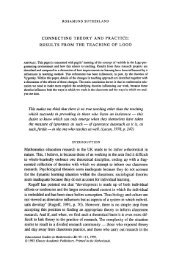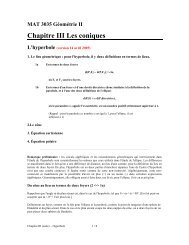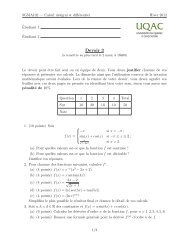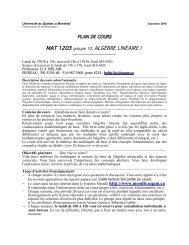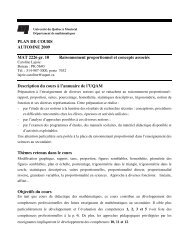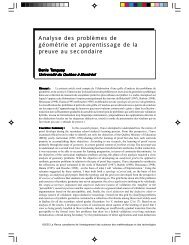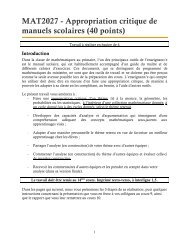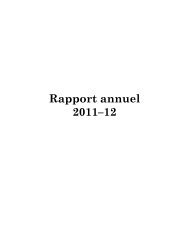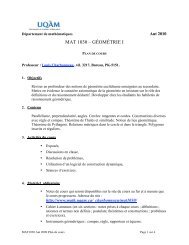COMPLEX GEOMETRY Course notes
COMPLEX GEOMETRY Course notes
COMPLEX GEOMETRY Course notes
Create successful ePaper yourself
Turn your PDF publications into a flip-book with our unique Google optimized e-Paper software.
Lemma 4.1.1. If F is a presheaf over X then there exists a unique sheaf F sh along with a morphism<br />
F −→ F sh that factors thorough all morphisms F −→ G to a sheaf G.<br />
F<br />
G<br />
ϕ ∃!<br />
F sh<br />
If X is a topological space, its structure sheaf CX 0 associated to each open subset U is given by the space<br />
of continuous functions on U. If X is an algebraic variety, its structure sheaf O X is given by the space of<br />
regular functions on (Zariski) open subsets. A complex algebraic manifold is also a complex manifold, and<br />
we write O alg<br />
X<br />
and Ohol X to distinguish the structures:<br />
O alg<br />
X<br />
O hol<br />
X<br />
−→ Zariski topology,<br />
−→ ordinary topology.<br />
Definition 4.1.3. Let A be the sheaf of rings over X. A sheaf F is called an A-module if for every open<br />
set U, F(U) is a module over A(U), compatible with the restriction maps.<br />
Remark 4.1.1. All notions from module theory carry over: Hom, Ker, Im, CoKer, direct sums, tensor<br />
products, exact sequences and homology groups, etc.<br />
Definition 4.1.4. The A-module A ⊕n = A is said to be free of rank n ∈ N.<br />
isomorphic to A ⊕n is called locally free of rank n.<br />
A sheaf that is locally<br />
Remark 4.1.2. There exists a bijection between vector bundles of rank n and locally free sheaves of rank<br />
n.<br />
If A is a sheaf of fields, the rank one sheaves (invertible sheaves with respect to A) form a group under tensor<br />
product, called the Picard group Pic OX (X).<br />
Definition 4.1.5. Let (f, f # ) : (X, A) −→ (Y, B) be a morphism of ringed spaces, i.e., f : X −→ Y is a<br />
continuous function, and<br />
f # : B(V ) −→ A(f −1 (V ))<br />
is a morphism for every open subset V compatible with restrictions. The pullback sheaf f ∗ G of a B-module<br />
G is defined as follows: set f (∗) G(U) = lim G(V ) and then set f ∗ G be the sheaf associated to the<br />
−→f(U)↩→V<br />
presheaf f (∗) G ⊗ f (∗) B A.<br />
Example 4.1.2. The sheaf F of holomorphic sections of a holomorphic vector bundles F over X,<br />
i X : {x} ↩→ X<br />
(1) i (∗)<br />
x F =: F x (the stalk of F at x and its elements are germs of sections of F at x).<br />
54



